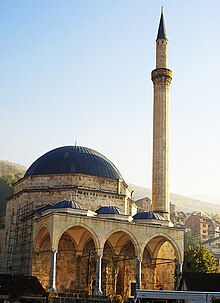Sinan Pasha Mosque (Prizren)
| Sinan Pasha Mosque | |
|---|---|
 | |
| Religion | |
| Affiliation | Islam |
| Status | preserved |
| Location | |
| Location | Prizren, Kosovo[a] |
 Shown within Kosovo | |
| Geographic coordinates | 42°12′31″N 20°44′29″E / 42.20861°N 20.74139°ECoordinates: 42°12′31″N 20°44′29″E / 42.20861°N 20.74139°E |
| Architecture | |
| Type | mosque |
| Style | Ottoman |
| Groundbreaking | 1600 or 1608 |
| Completed | 1615 |
| Specifications | |
| Length | 14 m (46 ft) |
| Width | 14 m (46 ft) |
| Minaret(s) | 1 |
| Minaret height | 43.5 m (143 ft) |
| Materials | stone |
The Sinan Pasha Mosque (Albanian: Xhamia e Sinan Pashës; Bosnian: Sinan-pašina džamija; Serbian: Синан Пашина Џамија; Turkish: Sinan Paşa Camii) is an Ottoman mosque in the city of Prizren, Kosovo.[a] It was built in 1615 by , bey of .[1] The mosque overlooks the main street of Prizren and is a dominant feature in the town's skyline.[2]
Sinan Pasha Mosque was declared a Monument of Culture of Exceptional Importance in 1990 by the Republic of Serbia.[3]
History[]
Sofi Sinan Pasha[4] started construction of the mosque in either 1600 or 1608.[2] Sofi Sinan Pasha, an Albanian and former beylerbey and kaymakam in Bosnia should not be confused with grand vizier Sinan Pasha, who built the in the nearby city of Kačanik.[4]
It is widely considered that the stones used to build the mosque were taken from nearby Saint Archangels Monastery, a Serbian Orthodox monastery founded by Serbian Emperor Stefan Dušan.[4][5] In fact, parts of the former monastery can be seen in the mosque.[2] The monastery, which was abandoned after the arrival of the Ottomans in the 16th century, had fallen to ruins by the 17th century. Hasan Kaleshi, an Albanian historian, sustained in 1972 that Sofi Sinan Pasha couldn't have possibly ordered any monastery destruction as this was impossible without a Sultan decree, rather, he ordered the use of the spare stones to a better deed as ordered by the Sultan.[4]
Description[]
The mosque covers roughly 14 m (46 ft) by 14 m (46 ft) and is square in shape. It has one large dome and another smaller half-dome that covers the mihrab, which is painted and has a stalactite hood. The mosque's walls are 1.65 m (5.4 ft) thick and its minaret, which is topped by a conical structure covered by lead, is 43.5 m (143 ft) in height.[2]
The walls and dome inside Sinan Pasha Mosque were painted in the 19th century, mostly of floral patterns and Qur'an verses. The minbar is painted with floral motives. Both the large dome and the half-dome of the mosque are covered with lead. The stone flooring of the mosque and the carpentry are original.[2]
Preservation concerns[]
Rain, which over time has entered the mosque via holes in the roof, has caused the loss of some original paintings on the walls and has led to the detachment of some of the wall plaster. Stones of the façade have faced weathering.[2]
Abdullah Gërguri worked on a series of repairs of the murals, particularly in the 1970s.
In early 2000 the cost to rehabilitate the building was estimated at about €500,000 by UNESCO.[2]
Manuscripts and use of building controversy[]
The Prizren municipality intended to build a library within the mosque in order to preserve not only the original Ottoman manuscripts found in the mosque, but also other valuable ones that can be found all over Kosovo. However, the Islamic Union of Kosovo filed a lawsuit against the Prizren Municipality in order to not allow the mosque to become a museum, but instead to have it continue to be a religious building.[4]
See also[]
- List of mosques in Kosovo
Notes[]
| a. | ^ Kosovo is the subject of a territorial dispute between the Republic of Kosovo and the Republic of Serbia. The Republic of Kosovo unilaterally declared independence on 17 February 2008. Serbia continues to claim it as a part of its own sovereign territory. The two governments began to normalise relations in 2013, as part of the 2013 Brussels Agreement. Kosovo is currently recognised as an independent state by 97 out of the 193 United Nations member states. In total, 112 UN member states have recognised Kosovo at some point, of which 15 states later withdrew their recognition. |
References[]
- ^ Elsie, Robert (2004). Historical dictionary of Kosova. Rowman & Littlefield Publishers, Inc. p. 145. ISBN 0-8108-5309-4.
- ^ a b c d e f g "Cultural Heritage in Kosovo" (PDF). UNESCO. Retrieved August 6, 2010.
- ^ Споменици културе у Србији - Sinan-pašina džamija
- ^ a b c d e Kaleshi, Hasan (1972). Najstariji vakufski dokumenti u Jugoslaviji na arapskom jeziku (in Serbo-Croatian and Albanian). Prishtine: Rilindja. pp. 257–264. Retrieved 2010-08-14.
- ^ M. Maksimović (22 January 2002). "Zadužbina cara Dušana" (in Serbian). Politika. Archived from the original on 21 July 2011. Retrieved 13 August 2010.
| Wikimedia Commons has media related to Sinan Pasha Mosque (Prizren). |
- Mosques in Prizren
- Ottoman mosques in Kosovo
- Religious buildings and structures completed in 1615
- 1615 establishments in the Ottoman Empire
- 17th-century mosques
- Cultural Monuments of Exceptional Importance (Serbia)
- Monuments and memorials in Kosovo

